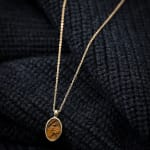



Roman
Hekate yellow jasper gold pendant, Roman Egypt, circa 2nd - 3rd century AD
Yellow jasper
Length of intaglio: 1.33 cm
Length of chain: 18 in (adjustable to 16 in)
Length of chain: 18 in (adjustable to 16 in)
Further images
A yellow jasper Gnostic intaglio depicting the triple-bodied goddess Hekate, set in a modern 18 carat gold pendant.
A yellow jasper Gnostic intaglio depicting the triple-bodied goddess Hekate, set in a modern 18 carat gold pendant.
Provenance
Private collection Mr. P.L., France, 1980sPrivate collection, UK, 1990s
Literature
The goddess Hekate was worshipped in some form from as early as the 8th century BC until the 4th century AD, with the earliest recorded reference in Hesiod’s, Theogony, 411ff. As an ancient chthonian deity, Hekate was primarily associated with the underworld. The goddess was an apotropaic deity believed to protect worshippers from demons and spirits and was given a triple body to illustrate her power over the sky, earth, and underworld and her fusion of the lunar goddesses Selene, Artemis, and Hekate. The goddess had few temples dedicated to her in antiquity, however small household shrines erected to ward-off evil were very popular.
Magical or Gnostic Gems were used mainly in Hellenised Egyptian Alexandria. They combined Egyptian, Classical, Jewish and Christian symbols concerned with the protection of the owner and the elevation of his soul from the physical to the spiritual.
For parallels see, A. Mastrocinque, Sylloge Gemmarum Gnosticarum, parte I, pp. 344-346.



